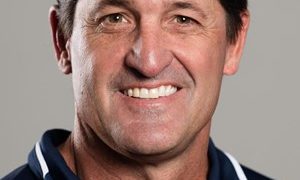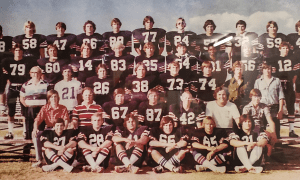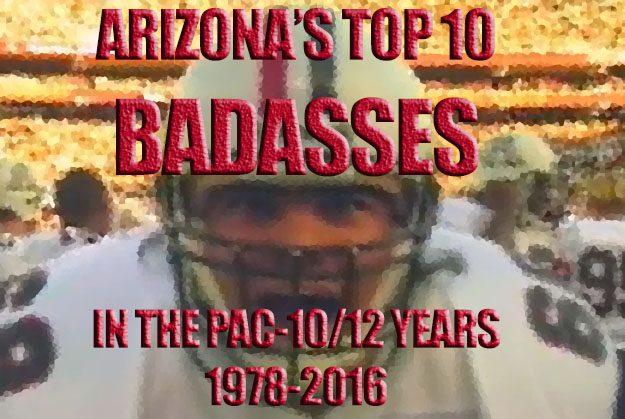
In 2011, when I blogged at TucsonCitizen.com, I put together the top 10 list of badasses in Arizona football during the Wildcats’ Pac-10/12 existence. To this day, it has developed somewhat of a cult following with even some former Arizona players talking about it.
Former linebacker Scooby Wright III was the latest entry in the list in 2014. He embodies the characteristic of a badass that is synonymous with how the Desert Swarm played at the time of his birth. In fact, Wright was born on Aug. 28, 1994, the same week Sports Illustrated ranked Arizona No. 1 and labeled the Wildcats as “Rock Solid”. Five members of the Desert Swarm, including College Football Hall of Famer Tedy Bruschi, were on the cover.
The dictionary definition for “badass”:

Bruschi was a badass similar to Wright, both of whom were under the radar when it came to recruiting during their high school careers in northern California. Wright is Arizona’s greatest sack threat since Bruschi and he recorded 29 tackles for lost yardage this season, second in school history.
Where does Wright, war paint and all on his face, rank among his badass brethren? Here are the top 10 rankings for offense and defense:
No. 10
Offense: NICK FOLES, quarterback (2009-11)
Former Oregon coach Chip Kelly once labeled Foles a “warrior” after Foles stomached five sacks and still completed 34 of 57 passes for 398 yards in the Wildcats’ 56-31 loss to the Ducks on Sept. 24, 2011 at Arizona Stadium. “I catch myself watching him in awe sometimes,” Kelly said. “Nick is a hell of a football player. That kid’s a warrior. He’s as good as anyone in the country.”
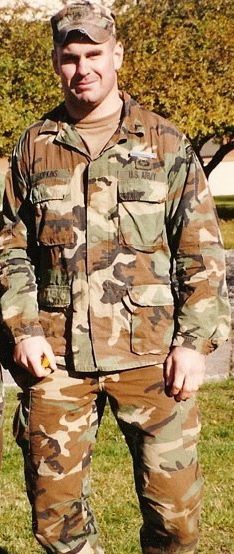
Defense: JIMMIE HOPKINS, defensive end (1990-93)
Hopkins opted out of spring practice in 1993, leading up to the season that the Wildcats finished 10-2 and beat Miami in the Fiesta Bowl. What’s so badass about that, you say? Hopkins missed spring practice because he joined the Army. His goal was to become an Airborne Ranger. And he later did serve in the military. Hopkins, overshadowed on the defensive line by Rob Waldrop, Ty Parten, Tedy Bruschi and Jim Hoffman, remained on campus, rejoined the team for fall drills and was an important contributor to the Desert Swarm defense.
No. 9
Offense: DENNIS NORTHCUTT, wide receiver (1996-99)
Northcutt, Arizona’s season receiving yards leader, caught eight passes for 121 yards and a touchdown in Arizona’s 31-24 win over USC in Tucson when he was a senior in 1999. That was only half of his contribution to the Wildcat victory. Also playing cornerback, Northcutt virtually shut down USC receiver R. Jay Soward, according to an Associated Press report of the game. Northcutt was on the field for 90 plays. As a freshman in 1996, Northcutt switched from cornerback to tailback to wide receiver to tailback to defensive back to receiver. He had two interceptions against Illinois that season, returning one 63 yards for a touchdown.

“He gave the pregame players-only scream down. When we left that room, we knew it was gonna be a war.” — former Arizona offensive lineman Eric Johnson said of Ty Parten (pictured), who gave a rousing pre-game speech before Arizona lost at No. 1 Miami 8-7 in 1992.
Defense: TY PARTEN, defensive tackle (1989-1992)
The Godfather of Arizona’s famed Desert Swarm defense arguably is Parten. As a senior captain in 1992, he lit a flame under the Wildcats (reeling from a 1-1-1 start) as they prepared to play on the Orange Bowl turf against top-ranked Miami. One of his teammates, offensive lineman Eric Johnson, once said: “He gave the pregame players-only scream down. When we left that room, we knew it was gonna be a war.” Arizona coach Dick Tomey sent the entire team to midfield for the coin toss and Miami answered by sending all of its players. Words were exchanged. The Wildcats, with Parten at the forefront, did not back down an inch.
No. 8
Offense: HICHAM EL-MASHTOUB, center (1991-94)
El-Mashtoub, a 295-pound center born in Beirut, Lebanon, and raised in Montreal, was viewed as reckless, engaging in a few fights during his Wildcat career. `If you’re not careful, he’ll put one right past you,” former Arizona offensive lineman Warner Smith told Anthony Gimino in an Arizona Daily Star article in 1994. “He’ll make people do what he wants them to do without them knowing it.” El-Mashtoub had a crucial fourth-quarter personal foul when he came off the bench and decked a tackler on the sideline after freshman Gary Taylor returned a kickoff to the 31 in the Cats’ 24-20 loss at California in 1993, a defeat that cost Arizona a spot in the Rose Bowl. El-Mashtoub was held out of the Hancock Bowl at the end of the 1993 season for fighting with a teammate in the locker room after a practice.Embed from Getty Images
Defense: BRANT BOYER, linebacker (1992-93)
Brant Boyer embodied the merciless image of Arizona’s Desert Swarm defense as a team captain in 1993. Boyer, a senior inside linebacker, talked tough and played that way. The Wildcats lost 8-7 at No. 1 Miami in 1992 in what was the coming-out party for the Desert Swarm. When Arizona was afforded the chance for a rematch in the Fiesta Bowl, Boyer did not hold back.
“This program will be on a new level,” Boyer was quoted as saying by the Miami Herald three days before the game. “When we beat Miami, it’s going to be a different story.”
No. 7

“As a coach, sometimes you try to put players in that situation — you try to break them down, you can see how much they can take — but Rob has a lot of resilience and a lot of physical and mental toughness.” — New England coach Bill Belicheck commenting on former All-Pro tight end Rob Gronkowski
Offense: ROB GRONKOWSKI, tight end (2007-08)
Gronk can make this list by his name alone, but there is more to his badass image than that while at Arizona and then with the New England Patriots. The play that introduced Arizona and its fans to Gronkowski’s toughness happened a month into his freshman season in 2007. His 57-yard touchdown hookup against Washington State was Gronk-esque. Gronkowski caught the pass from Willie Tuitama at the Wazzu 31, bounced off a defender like a battering ram, almost lost his footing at the 10, and reached the end zone to give the Wildcats a 41-20 lead. New England coach Bill Belicheck told the NFL Network about Gronkowski: “Rob works very hard. He comes early, he stays late. He’s very physically and mentally tough. You can’t really get him down, you can’t break him. He can really fight through it. As a coach, sometimes you try to put players in that situation — you try to break them down, you can see how much they can take — but Rob has a lot of resilience and a lot of physical and mental toughness.”

“With the (knee) injury, it got me to sit back and see, to think. I never said why me? Why not me? I play a violent game, I was in a lot of pile ups before that and never got hurt. That was football,” — Arizona linebacker great Byron Evans
Defense: BYRON EVANS, linebacker (1983-86)
Arizona has not featured a better pursuit defender than Evans in the history of the program, except for Ricky Hunley, another linebacker who defined what being a badass is all about during his heralded career. During Evans’ senior season at Arizona in 1986, he averaged 17.3 tackles per game as a middle linebacker. To put that into perspective, Scooby Wright averaged a team-high 11.6 tackles a game in 2014 when he earned his national accolades as a top defender. Since the Wildcats joined the Pac-10 in 1978, Hunley and Evans are the only players to register at least 100 unassisted tackles in a season. Hunley achieved 100 in 1982, and Evans posted 118 in 1985 and 111 in 1986. Evans was eight years into his NFL career with Philadelphia when he suffered a career-ending knee injury. “With the injury, it got me to sit back and see, to think. I never said why me? Why not me? I play a violent game, I was in a lot of pile ups before that and never got hurt. That was football,” Evans told NFLPlayerEngangement.com in December.
No. 6
While at Arizona, Glenn Parker got a tattoo on his bicep of the block “A” helmet logo of the Wildcats. A skull and crossbones is through the letter. Parker also had a goatee and wore a bandanna, so he carried the look of a badass quite well.
Offense: GLENN PARKER, offensive guard (1988-89)
How does a guy who did not play high school football and was a self-described beach bum become an All-Pac-10 player at Arizona and five-time Super Bowl participant in a 12-year NFL career? Or a badass, for that matter? Dedication, hard work and toughness — these are some of the words used to describe Parker during his time at Golden West College in Huntington Beach, Calif., Arizona, and with Buffalo, Kansas City and the New York Giants in the NFL. While at Arizona, Parker got a tattoo on his bicep of the block “A” helmet logo of the Wildcats. A skull and crossbones is through the letter. Parker also had a goatee and wore a bandanna, so he carried the look of a badass quite well. “People will always try and make something out of it,” Parker told the Los Angeles Times. “But it’s just me. I just try and look like a madman when I’m on the field.”Embed from Getty Images
Defense: MARCUS BELL, linebacker (1996-99)
Former Arizona coach Dick Tomey said of the diminutive 6-2, 235-pound Bell in a 1999 Sports Illustrated article: “He’s the best linebacker we’ve ever had here. He’s a tenacious competitor, and he runs like a defensive back.” Tomey likely meant that Bell was the best linebacker since he started coaching Arizona in 1987. Hunley, Evans and Chris Singleton — all Larry Smith recruits — might have something to say about who is the best linebacker. Bell, however, is one of the elite linebackers in the program’s history and he certainly belongs on this badass list of Wildcats. How much did Bell hate to lose? The last time he played ASU in Sun Devil Stadium — in 1999 when the Wildcats lost 42-27 — he was the last player left in the locker room more than 30 minutes after the game ended. That was also the last game of his college career. He sat alone, still wearing his uniform, reflecting on what went wrong.
No. 5
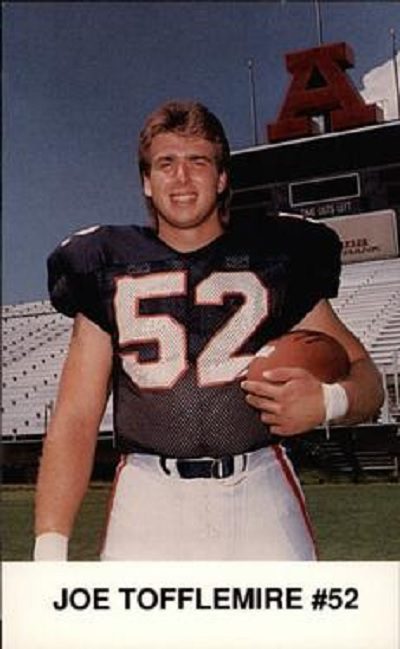
Offense: JOE TOFFLEMIRE, center (1985-1988)
The late Joe Tofflemire, who passed at 46 because of heart failure in September 2011, is an example of a genuinely good human being who was an undeniable force on the field, a veritable badass. “He was the complete leader,” former Arizona offensive lineman standout John Fina told Anthony Gimino of TucsonCitizen.com after Tofflemire’s passing. “He would get up and talk and lead by example. He didn’t tolerate any lackadaisical attitude from himself or from anyone else. He wanted to win football games, and anyone who wasn’t willing to be a part of that wasn’t going to be a friend of his.”Embed from Getty Images
“It’s so fun to watch (Scooby Wright) play because every snap is going to be the last snap he ever plays. You hope all your players emulate that, but he truly does all the time, even in practice, and I think that’s what makes him so effective.” — Arizona coach Rich Rodriguez
Defense: SCOOBY WRIGHT III, linebacker (2013-15)
Former Cal quarterback Jared Goff told ESPN in 2014 the hardest hit he took in football happened not in college, but in high school. Goff remembers who leveled him despite getting his bell rung. “Scooby Wright hit me really hard in a high school game … that might have been it,” Goff told ESPN. Wright, the most decorated defender in the program’s history, fractured his ankle in the second quarter of that high school game but that did not stop him. “I attempted to play, let’s put it that way,” Wright said. “I wasn’t too active. My coach tried to take me out and I said no. I think I played the whole game.” Arizona coach Rich Rodriguez said in the ESPN article: “It’s so fun to watch him play because every snap is going to be the last snap he ever plays. You hope all your players emulate that, but he truly does all the time, even in practice, and I think that’s what makes him so effective.”
No. 4
Offense: KELVIN EAFON, fullback/tailback (1996-1998)
Arizona’s offensive captain during its 12-1 season in 1998 was not Ortege Jenkins, Keith Smith, Dennis Northcutt or Trung Canidate. That responsibility was given to Eafon, who originally came to Arizona to play basketball but found his place on the football field through hard work. “If we could all play as hard and as tough as Kelvin Eafon, we would win every game we played,” Tomey said in a 1997 Seattle Times article. In the 1996 Territorial Cup game in which the Rose Bowl-bound Sun Devils routed the Wildcats 56-14 at Arizona Stadium, ASU offensive linemen Glen Gable broke defensive lineman Daniel Greer’s ankle with an illegal blind-sided clip during a return. That sparked Eafon, who noticed the play and witnessed Tomey yelling at Gable, to sprint off the bench to knock down Gable. Eafon and Gable were ejected. The retaliation showed how much Eafon revered his teammates.Embed from Getty Images
“How do I sum it up? How do I feel about Tedy Bruschi in five seconds? He’s a perfect player. He’s helped create a tradition here we’re all proud of. He’s a perfect player. He’s a perfect player.” — Bill Belicheck during Bruschi’s retirement press conference in 2009
Defense: TEDY BRUSCHI, defensive end (1992-1995)
Being a badass can be uplifting to not only a football program, but also a community, and a nation. Tedy Bruschi is a Wildcat legend and a Tucson favorite because of how he emerged from obscurity, perceived to be too small and slow out of high school (6 feet and 230 pounds), to become the school’s all-time sack leader with 55. That’s more than double the next guy on the list — defensive end Ricky Elmore — who accumulated 25.5 sacks from 2007-10. While with the New England Patriots, Bruschi — appropriately nicknamed “Full Tilt” — became a national hero when he returned to the field midway through the 2005 season after suffering a minor stroke. “How do I sum it up? How do I feel about Tedy Bruschi in five seconds?” Belichick said during Bruschi’s retirement press conference in 2009. “He’s a perfect player. He’s helped create a tradition here we’re all proud of. He’s a perfect player. He’s a perfect player.”
No. 3

After making a leaping catch among defenders at ASU, barely landing inbounds, Richard Dice limped to the Arizona bench raising his middle finger to the ASU crowd, which was riding him. The Wildcats won 31-28.
Offense: RICHARD DICE, wide receiver (1993-1996)
In a 2007 article for the print edition of the Tucson Citizen, Anthony Gimino described the undeniable badass nature of Dice, a throwback if there ever was one in the Arizona program. “Dice is remembered for his fire, a never-say-die player who wouldn’t be deterred by a torn left ACL in 1995,” Gimino wrote in a preview of the Arizona-ASU football game. The prolific receiver — who ranks in Arizona’s top 10 in career touchdown receptions (17) and receiving yards (1,957) — opted to not have late-season surgery. The swelling was reduced enough by game time to allow him to play when the Wildcats traveled to Tempe in 1995. Dice and quarterback Dan White spearheaded a comeback from a 14-point deficit in the fourth quarter with three receptions. After making a leaping catch among defenders at ASU, barely landing inbounds, Dice limped to the Arizona bench raising his middle finger to the ASU crowd, which was riding him. The Wildcats won 31-28.Embed from Getty Images
“I’m convinced there would not have been a Desert Swarm defense without Rob Waldrop (pictured). We had a lot of great players on that team, but it started and ended with that guy.” — former Arizona linebacker Brant Boyer, a badass himself, commenting about the Wildcats’ Hall of Fame nose tackle
Defense: ROB WALDROP, defensive tackle (1990-1993)
This badass list already has four members of the Desert Swarm — No. 4 Bruschi, No. 8 Boyer, No. 9 Parten and No. 10 Hopkins — but none of these standouts was as dominant as Waldrop. “What he did in college speaks for itself,” Boyer told TucsonCitizen.com in May 2011 when it was announced that Waldrop was selected to the College Football Hall of Fame. “I’m convinced there would not have been a Desert Swarm defense without Rob Waldrop. We had a lot of great players on that team, but it started and ended with that guy.” Waldrop was a significant reason why the Desert Swarm led the nation and set a Pac-10 record with 33 rushing yards allowed per game in 1993. He finished his Arizona career with 164 tackles, a remarkable feat for an interior lineman, with 44 tackles for lost yardage and 22.5 sacks, which ranks fifth in Arizona’s history. Former teammate Heath Bray told Gimino of Waldrop: “We’d see him laying out in the sun, and I’d say, ‘You need to lay out in the sun because you are one damn cold-blooded reptile.’”
No. 2

“One of the main things that motivated me was people saying I couldn’t do it. I wanted my mom (Clarice Adams) to be proud of me and football was what I was best at.” — Arizona tough-as-nails running back David Adams
Offense: DAVID ADAMS, tailback (1984-1986)
David Adams is the most extreme example of a Wildcat who answered quite emphatically those critics who claimed he was too small to succeed. The Atlanta Constitution-Journal described Adams as a “waif with wings” before the Wildcats played Georgia in the 1985 Sun Bowl. The Sunnyside High School graduate was listed at 5’6″ and 165 pounds during his Wildcat career. Former Arizona coach Larry Smith found promise in Adams where others did not. “He keeps his nose to the grindstone,” the late Smith often said about Adams during the tailback’s career. “One of the main things that motivated me was people saying I couldn’t do it,” Adams told me. “I wanted my mom (Clarice Adams) to be proud of me and football was what I was best at.” Adams, who led the Pac-10 in rushing his senior season in 1986 with 1,175 yards on 238 attempts, made believers out of his opponents. Former Oregon safety Anthony Newman, whose team allowed Adams to rush for 130 yards in a 41-17 loss in 1986, told the Eugene (Ore.) Register-Guard: “David Adams is very hard to tackle … He is so quick, yet he’s still willing to run over you and strong enough to do it.”Embed from Getty Images
“I want to run through people. I want a hit you’ll hear for days. I dream, I mean dream, of hitting a wide receiver in midair. Something hellacious. If a team has no business on the field with us, I want to let ‘em know it.” — Arizona Hall of Fame linebacker Ricky Hunley
Defense: RICKY HUNLEY, linebacker (1980-1983)
Not too long after Hunley traveled west from Petersburg, Va., in 1980, he became the most talented and athletically gifted badass to play for the Wildcats. He was one of 11 children who grew up in the Hunley household, which included younger brother Lamonte, who also became a standout linebacker with the Wildcats. Lamonte was only a year behind Ricky, so Arizona fans were treated to three seasons of the Hunley brothers wreaking havoc on Pac-10 offenses. When Arizona was ranked No. 3 by the Associated Press in 1983, Ricky’s senior season, Sports Illustrated described the brothers as, “Fire and Smoke, Mean and Nasty, Gotcha Now and Getcha Later.” “I want to run through people,” Ricky told SI. “I want a hit you’ll hear for days. I dream, I mean dream, of hitting a wide receiver in midair. Something hellacious. If a team has no business on the field with us, I want to let ’em know it.” Hunley, the highest NFL draft pick in Arizona history (seventh selection overall in 1984, by Cincinnati), is the Wildcat record-holder with 566 career tackles.
No. 1
Offense: No. 1 JAY DOBYNS, wide receiver (1982-1984)
“Every Saturday a kid who barely weighs 170 pounds dripping wet goes over the middle for us. I know this Jay is a tough, reckless, S.O.B. After games, he looks like he’s been run over by a train. I personally think he enjoys taking the defenses’ best shot just so he can get up and laugh at them.” — former Arizona coach Larry Smith, as quoted by the Arizona Daily Wildcat in 1984.
Most people know about Jay Dobyns as a badass off the football field as an undercover agent for the U.S. Bureau of Alcohol, Tobacco and Firearms (ATF). Dobyns was also every sense of the word while with the Wildcats.
Dobyns was a favorite target of quarterbacks Tom Tunnicliffe and Alfred Jenkins, especially over the middle of the field in traffic. Tunnicliffe and Jenkins knew that chances were if they threw in Dobyns’ direction, he had the hands and the toughness to secure the ball despite being defenseless against tacklers.

Dobyns also played hurt on many occasions. One time, after severely bruising a thigh, he was on crutches the day after the game. However the day after that, on Monday, he tried to jog off the pain. The coaches were amazed that Dobyns even tried to work his way back so fast. He was held out of the following week’s game as a precaution, much to his frustration.
“Jay was a leader on my teams,” the late Smith, Arizona’s coach from 1980-86, is quoted as saying on Dobyns’ Web site. “He is a leader in our community, and he was a one of those players that becomes special to a coach because he did everything asked of him to win.”
A Sahuaro High School grad, Dobyns played a year at Arkansas before transferring back to Tucson to play for his hometown team. He was a three-year starter. He became an All-Pac-10 honorable mention selection in 1983 and 1984, and was named to the Arizona Daily Star’s All-Century team for Arizona as wide receiver in 1999.
Leo Banks of the Tucson Weekly aptly described Dobyns’ experience as an Arizona football player this way in a 2009 article:
He grows up mainly on Tucson’s eastside, loving football, loving the UA. On game days, he rides the bus from Speedway Boulevard and Camino Seco to campus to get his ticket. He dreams of one day playing on the same field, and the dream comes true. He starts for UA at wideout for three seasons in the early ’80s. Former teammate Glenn Howell says, “Nobody was going to outwork Jay. Man, he was a workout freak.” When the gates to the field are locked, because it’s against the rules to practice, Dobyns and Howell hop the fence and go to work running routes. Dobyns isn’t fast, but he catches everything. If the quarterback throws the ball off the moon, he goes up and gets it. He wins all Pac-10 honorable mention his junior and senior years. “I didn’t have much raw talent, but I played like a maniac,” says Dobyns. “I had to if I wanted playing time. I threw fear out the window, played the hardest I could, and it carried over to ATF.”
Dobyns, alias Jaybird, became an ATF agent in 1987, only three years after playing his last game with the Wildcats. As a rookie agent only four days on the job, Dobyns was taken hostage in a sting operation and shot through the chest in the desert near Sahuarita. A year later, he was run over by gangsters in a getaway car.
Just like those safeties who failed to jar Dobyns with vicious tackles, the criminals could not stop him.
“Getting cheered by 80,000 football fans was an incredible feeling,” Dobyns writes in his New York Times best-seller, NO ANGEL: My Harrowing Undercover Journey To the Inner Circle of the Hells Angels. “But it didn’t even register when compared to the rush of walking the line between life and death when no one was watching.”
He gained international notoriety after he infiltrated the Hells Angels motorcycle club from 2001 to 2003. Dobyns was offered membership to the Hells Angels after faking the murder of a rival gang member and providing the fabricated evidence of the murder to Hells Angels leaders, convincing them of his credibility. Dobyns spent the majority of his ATF career working in varied assignments developing undercover expertise in violent crime investigation, narcotics, firearms, gang infiltrations, home invasion robbery cases, and murder-for-hire investigations.
He was an undercover agent in more than 500 operations and won 12 ATF “Special Act” awards for investigative excellence. In 2004, the National Association of Police Officers presented Dobyns the “Top Cop” award after his infiltration of Hell’s Angels that resulted in 43 felony arrests.
His tough-guy image with the shaved head, goatee and tattoos is a far cry from his surfer look while at Arizona.
“I kind of fell in love with my props,” Dobyns told Newsweek in a 2009 interview. “It became who I was. … (I miss) the rush of riding in a pack of gangsters at 85 miles per hour, only 18 inches apart. That’s a rush that even catching a pass in front of 70,000 people in a stadium can’t match.”
When Lute Olson coached at Arizona, he invited Dobyns to speak to his players.
“Jay Dobyns has spoken to my team and his message is inspirational,” Olson is quoted as saying by Dobyns’ Web site. “Our kids absolutely loved him. They thought he was one of the best speakers they have heard in all their years at the University of Arizona.
“His story is one of courage and heroism. You will be on the edge of your seats when you listen to Jay speak.”
Defense: No. 1: CHUCK CECIL, safety (1984-87)
In 1983, When Stanford did not offer a scholarship to Cecil — 6-feet and a scant 150 pounds out of San Diego Helix High School — that helped fuel the fire for the “Heat-Seeking Missile” to succeed with the Wildcats. The Cardinal coaching staff at the time reportedly told Cecil he was too small for major college football.
Cecil, who waited on Stanford’s decision with great anticipation, opted to follow the advice of former Arizona assistant Moe Ankney and walk on to the Arizona program. His wait for Stanford cost him a chance for a scholarship with Arizona as a freshman because the Wildcats used their allotment of grants.

“He and his parents took a gamble,” Ankney told the Toledo Blade in 1987 when he prepared to coach against Arizona as the Bowling Green head coach. “They paid for his first year of college and I made a commitment to them that I’d get him grant-in-aid as soon as possible.”
Cecil, a three-time Pac-10 All-Academic selection as a safety, dedicated himself to earn that scholarship but his goals went far beyond that. A bookworm does not get the nickname “Heat-Seeking Missile”, given to the vicious-tackling Cecil by a North Carolina assistant coach after Arizona beat the Tar Heels 30-21 in the 1986 Aloha Bowl, their first bowl win in 65 years.
Former Arizona assistant Duane Akina scouted that game for the Calgary Stampeders of the Canadian Football League. Akina told Anthony Gimino of TucsonCitizen.com in 2009 that he was in awe of Cecil’s hits on North Carolina’s receivers and running backs. Cecil was responsible for causing two fumbles in the game.
“Chuck had some great hits. I remember sitting in the stands going, ‘God, I wonder who that kid is?’ ” Akina said. “When I got to Arizona (in 1987 as an assistant under newly-hired coach Dick Tomey), everyone was talking him up. And then when I saw him, I was like, ‘That’s him? This scrawny 180-pound kid?’ I thought I was going to see Ronnie Lott.”
Lott, a legendary NFL player nicknamed “The Intimidator”, may have been bigger than Cecil, but he had nothing on Cecil when it came to being a badass. In his sophomore season, Cecil played with a left thumb so badly broken that a doctor reportedly later said it looked as though it had been smashed with a hammer. His trademark was his bone-crunching tackles.
“He’s just like Chi Chi Rodriguez hitting a golf ball,” Tomey told Sports Illustrated in a 1987 interview. “Everything he has is there at the right time.”
Cecil, who maxed out at 6’1″, 185 pounds, had the best season for an Arizona safety when he was a senior in 1987, recording 136 tackles, breaking up 12 passes and intercepting nine. He finished his Arizona career with a record 21 interceptions, which still stands as the school record.
His hard-hitting style drew plenty of fines from the NFL, which considered his style a detriment to the league. Sports Illustrated ran an article in 1993 of Cecil, who was on the cover with the title: “Is Chuck Cecil too vicious for the NFL?”
“They’re saying what I do is dirty and cheap, but I’ve played this way forever,” Cecil told SI. “I signed a million-dollar contract because of it. People cheer when I make a big hit. I mean, that’s what I do.”
Cecil’s legendary status at Arizona was solidified in the Cats’ 34-17 victory over Rose Bowl-bound ASU in 1986. That’s when he returned an interception for 100 yards in what is the greatest play in the history of the program.
“I would say Chuck had the most dynamic personality of anybody I’ve coached,” Akina told Gimino. “He probably affected his teammates more than any player I’ve had. That is true leadership. I have never coached another like him who could carry the classroom to the field and who was so damn tough.”
Here’s the honorable mention of the others who did not make the top 10 lists (players are from when the Pac-10 formed in 1978 to now): OFFENSE: Samajie Grant, WR; Keith Smith, QB; Warner Smith, OL; Mark Walczak, TE; Cullen Plousha, WR; Jeff Kiewel, OL; Brad Anderson, WR; Tom Tunnicliffe, QB; Mike Thomas, WR; Charlie Dickey, OL; Mike Freeman, OL; John Fina, OL; Terry Vaughn, WR; and Trung Canidate, RB. DEFENSE: Brandon Sanders, DB; Chuck Osborne, DT; Jimmy Sprotte, LB; John Kaiser, LB; Antonio Pierce, LB; Lance Briggs, LB; Ivan Lesnik, DT; Donnie Salum, LB; Adrian Koch, LB; Ricky Elmore, DE; Mike Scurlock, CB; Randy Robbins, DB; Chris McAlister, DB; Brooks Reed, DE; Cleveland Crosby, DT; Dana Wells, NG; Darryll Lewis, DB; Dave Liggins, DB; Lamonte Hunley, LB; Chris Singleton, LB; Jeff “The Hammer” Hammerschmidt, DB; Joe Salave’a, DT; Spencer Larsen, LB; Glenn Perkins, LB; Stan Mataele, DT; DaShon Polk, LB; and Gordon “Crunch” Bunch, DB.
FOLLOW @JAVIERJMORALES ON TWITTER!
ALLSPORTSTUCSON.com publisher, writer and editor Javier Morales is a former Arizona Press Club award winner. He is a former Arizona Daily Star beat reporter for the Arizona basketball team, including when the Wildcats won the 1996-97 NCAA title. He has also written articles for CollegeAD.com, Bleacher Report, Lindy’s Sports, TucsonCitizen.com, The Arizona Republic, Sporting News and Baseball America, among many other publications. He has also authored the book “The Highest Form of Living”, which is available at Amazon.












